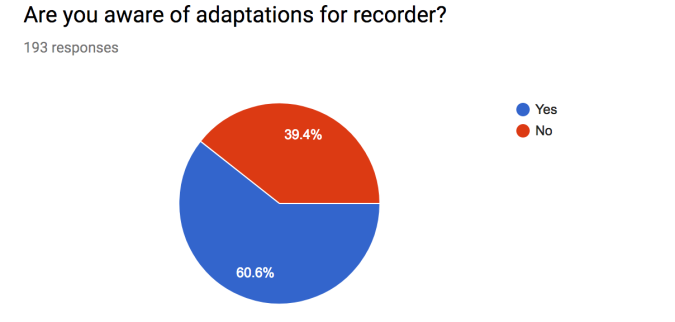Two months ago I created a survey to study music teachers’ awareness and use of adaptations for the recorder. I received responses from 193 teachers, the majority of whom live in the United States, and 94.8% of whom teach recorder in their classes.
As expected, the recorder is primarily taught at the elementary level.

29.5% of the teachers surveyed teach students with physical disabilities. The following statistic proves that more work can be done to help teachers learn about adaptations.

I suspect that 39.4% is actually a lower statistic than it might be otherwise. I advertised my survey primarily in teacher networks that I know, and I answer questions about recorder adaptations frequently in those circles. It would be interesting to conduct a larger study with music teachers who have no connection to me.
Teachers knew about a variety of recorder accommodations. The most frequently mentioned instrument was the Aulos 204AF Recorder for Students with Finger Disabilities. The Triple Play by Makers4Good was also referenced.
Adaptations teachers mentioned included tape, stickers, thumb rests, neckstraps, braces, and a microphone stand. Player adjustments included hand position, fingering, and help from a paraprofessional. Other solutions included color coding, limiting tonesets in melodies and harmonies, labeling holes, using iPads, large print, braille, and using a melodica.
I also asked teachers about which adaptations they have actually used with students. Answers were similar to the previous question. In addition, teachers used hole punch reinforcement stickers, Wikki Stix, raised foam, barred instruments, and alternative fingerings.
Given the range of students that a school teacher typically sees, it is difficult to develop expertise to accommodate all students. Music teachers might have one course on special education in undergraduate degrees. Further coursework may be required to maintain certification, and teachers can learn more through professional development and by collaborating with colleagues. The following chart indicates that many teachers do not feel well prepared to work with students with physical disabilities.

1 = strongly disagree 5 = strongly agree
I was curious to learn about how well teachers thought their schools provided for those who need adaptations.

I separated these results by non-public vs. public school teachers. Non-public school teachers had higher percentages of “Strongly agree” (25% vs. 10.7% in public) and “Strongly disagree” (15.6 vs. 6%). More public school teachers reported “agree” (48.3% vs. 21.9% in non-public). Overall, it seems that many schools do budget for supplies for students with special needs.
The current adaptations for recorder are limited, and certainly more can be done to make the instrument accessible to more students. Still, any adaptations are useless unless people are aware of them. It is important to help teachers find the resources they need to create the richest musical environment for their students. This includes giving all students access to instrumental music.
This survey was designed using Google Forms and administered between February 11-21, 2018.
Awesome, Valerie. I’ll be forwarding this to my students.
Thanks,
On Sat, Apr 7, 2018 at 1:30 PM Another Way to Play wrote:
> ValerieThomforde posted: “Two months ago I created a survey to study music > teachers’ awareness and use of adaptations for the recorder. I received > responses from 193 teachers, the majority of whom live in the United > States, and 94.8% of whom teach recorder in their classes. As” >
LikeLike
Valerie: I have been looking into adaptive recorders and I am interested in the Recorders for All device, but I have a student whose different limb is much too short to reach this device. Do you have any suggestions for a way to adapt it so that he can play?
LikeLike
Hi Lynne, For your student, the Recorders for All device will not be any more useful than a regular recorder. The Aulos Recorder would give your student a few more notes, though he still wouldn’t be able to play the full range. You can also experiment with harmonies and bass lines that can be played with one hand on soprano, alto, and sopranino recorders. I am not sure if they are available yet, but there is a 3D printed recorder for one hand. It was designed by Paul Yeomans at the Birmingham City University School of Jewellery based on the design of Peter Worrell. This recorder just won an award at the 2018 OHMI Conference: https://www.ohmi.org.uk/2018-ohmi-competition-winners.html
LikeLike